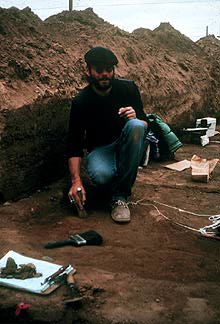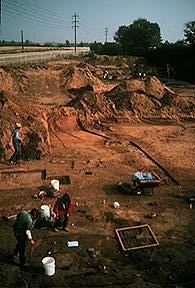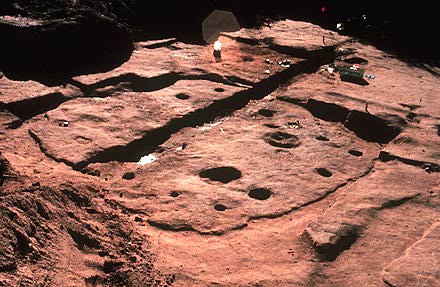
In late 1987 and early 1988, Archaeological Consulting Services Ltd., a private archaeological company in Tempe, performed excavations at the site of La Ciudad de los Hornos. The site of La Ciudad de los Hornos is a very large and complex Hohokam village that covers nearly a square mile. This site might have been occupied from as early as A.D. 450 to as late as A.D. 1450. The Spanish word for oven in "horno" and the name of the site (los hornos) is derived from the large number of communal ovens observed by Frank Cushing when the site was first recorded nearly one hundred years ago.
The purpose of this assignment is to give you a basis for understanding how archaeologists build chronological sequences. Time is of vital interest in order to study processual changes in behavior, perhaps the primary goal of archaeological research. The first part of this exercise focuses on data that you will use to order features (pithouses) using a seriation method of dating. This is a relative dating procedure that can be useful in reconstructing a basic sequence. A series of chronometric dates will be provided. Both radiocarbon 14 and archaeomagnetic dates that were derived from some of the features will be used to calibrate and adjust the sequence you established using the seriation data. Once you have completed the chronological evaluation, you can attempt to relate this to other reconstructions of behavioral from data taken from excavated features, in this case directly from house floors.
Forty structures or fragments of structures (features known as pithouses for
 Hohokam
archaeology) were identified during the excavations. Twenty-six (26) of
these were excavated completely. Features were excavated using arbitrary
levels. Ceramics from the floor level and 10 centimeters above the floor
were collected and analyzed. These were typed according to tradition ceramic
types for the Hohokam culture. Types such as Santa Cruz red-on-buff, Gila
Buttes red-on-buff, Sacaton red-on-buff were recorded. Ceramics from three
broad time periods were recognized. These periods were the Pioneer, Colonial,
and Sedentary. These would roughly place the features in a range from A.D.
500 to 1150.
Hohokam
archaeology) were identified during the excavations. Twenty-six (26) of
these were excavated completely. Features were excavated using arbitrary
levels. Ceramics from the floor level and 10 centimeters above the floor
were collected and analyzed. These were typed according to tradition ceramic
types for the Hohokam culture. Types such as Santa Cruz red-on-buff, Gila
Buttes red-on-buff, Sacaton red-on-buff were recorded. Ceramics from three
broad time periods were recognized. These periods were the Pioneer, Colonial,
and Sedentary. These would roughly place the features in a range from A.D.
500 to 1150. Hohokam pithouses were constructed as "houses in pits". Using wood poles, arrow-weed, and mud, walls were constructed around the periphery of a shallow pit in which the actual floor of the pithouse was lined with caliche. Caliche is a naturally occurring limestone deposit in southern Arizona deserts. When wet, this deposit can be manipulated, but when it hardens, it is like concrete. Many of the floors at Los Hornos had caliche about 3 to 5 cm. in thickness. Pithouses are of different sizes and shapes.
